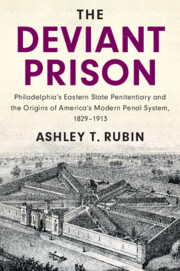 The Deviant Prison
The Deviant Prison Book contents
- Frontmatter
- Contents
- List of Figures
- List of Tables
- Acknowledgements
- List of Abbreviations
- A Brief Timeline
- Important Actors
- Introduction
- Part I Becoming the Deviant Prison: Establishing The Conditions for Personal Institutionalization
- Part II THE ADVANTAGE OF DIFFERENCE: The Process of Institutionalization
- 5 Neutralizing the Calumnious Myths: Administrators’ Public Defense of the Pennsylvania System
- 6 Combatting the Pains of Deviance: Organizational Defense As Self-Defense
- B Behind the Scenes
- 7 Strategic Manipulations: Acceptable and Unacceptable Violations of the Pennsylvania System
- 8 Turning a Blind Eye: Reputation and the Limits of Administrative Commitment
- Part III Forced to Adapt: The Conditions for and Process of Deinstitutionalization
- Appendix A Inspectors
- Index
8 - Turning a Blind Eye: Reputation and the Limits of Administrative Commitment
from Part II - THE ADVANTAGE OF DIFFERENCE: The Process of Institutionalization
Published online by Cambridge University Press: 12 January 2021
- Frontmatter
- Contents
- List of Figures
- List of Tables
- Acknowledgements
- List of Abbreviations
- A Brief Timeline
- Important Actors
- Introduction
- Part I Becoming the Deviant Prison: Establishing The Conditions for Personal Institutionalization
- Part II THE ADVANTAGE OF DIFFERENCE: The Process of Institutionalization
- 5 Neutralizing the Calumnious Myths: Administrators’ Public Defense of the Pennsylvania System
- 6 Combatting the Pains of Deviance: Organizational Defense As Self-Defense
- B Behind the Scenes
- 7 Strategic Manipulations: Acceptable and Unacceptable Violations of the Pennsylvania System
- 8 Turning a Blind Eye: Reputation and the Limits of Administrative Commitment
- Part III Forced to Adapt: The Conditions for and Process of Deinstitutionalization
- Appendix A Inspectors
- Index
Summary
This chapter describes what the Pennsylvania System looked like in practice, focusing on deviations from the Pennsylvania System's idealized regimen that its administrators vehemently defended. Quite at odds with their extensive public proclamations of their system's excellence, the administrators often subverted the Pennsylvania System's ultimate goals or directly broke its most central rules. This chapter explains the administrators' apparently paradoxical behavior by demonstrating that these deviations were part of an effort to reduce the Pennsylvania System's vulnerability to further criticism. Their management decisions at the prison were intensely pragmatic, guided not by a perfect belief in the Pennsylvania System or even penological goals, but by the desire to reduce expenses and prevent insanity—the Pennsylvania System's biggest weaknesses according to its critics. The administrators sought to prevent manifestations of the calumnious myths so they could continue to claim their system's superiority and protect their own status as benevolent, humane gentlemen running a model prison—a status that kept the Pennsylvania System personally institutionalized at Eastern.
Keywords
- Type
- Chapter
- Information
- The Deviant PrisonPhiladelphia's Eastern State Penitentiary and the Origins of America's Modern Penal System, 1829–1913, pp. 230 - 258Publisher: Cambridge University PressPrint publication year: 2021


